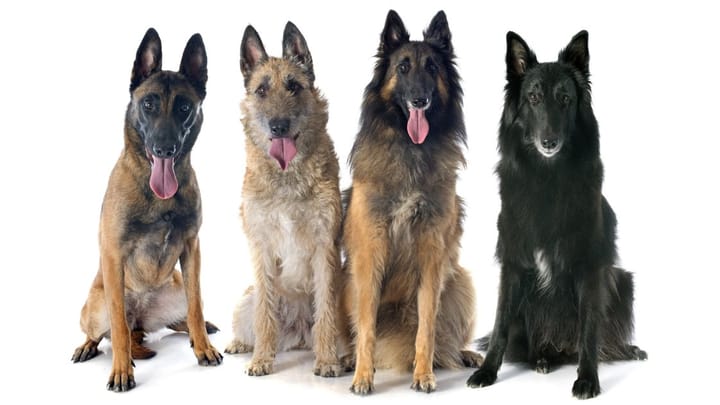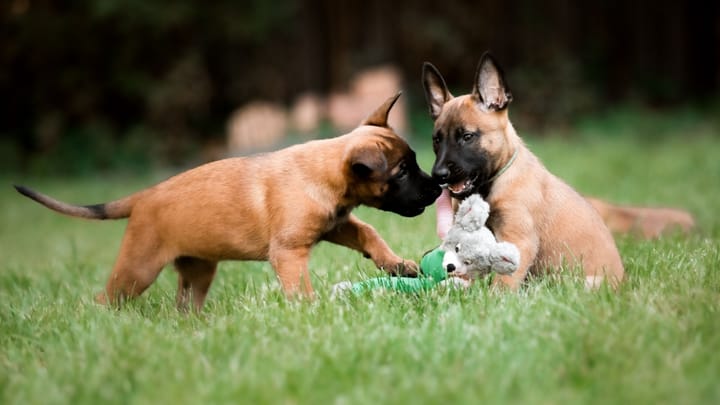Belgian Shepherd
Other names : Malinois, Groenendael, Tervueren, Laekenois, Belgian Shepherd Dog


The Belgian Shepherd is a keen working dog, a little nervous, overflowing with energy and vitality and always ready to carry out tasks given. Naturally the herder of flocks, they are also used to guard a property. Four varieties exist: the Malinois, who was specifically selected for guarding, defence and sporting activities; the Groenendael, the Terveuren and the Laekenois, who preserve the calm and bold side of the shepherd.
|
Life expectancy |
The Belgian Shepherd has a life expectancy of between 10 and 14 years |
|
Temperament |
|
|
Size |
Medium
|
|
Adult size |
Female
Between 22 and 24 in
Male
Between 24 and 26 in
|
|
Adult weight |
Female
Between 44 and 55 lb
Male
Between 55 and 66 lb
|
|
Coat colour
The Groenendael has a black coat. The Malinois and Tervueren have all shades of red, fawn, grey with black overlay. The Laekenois has a reddish fawn colour with black shading, principally on the muzzle and tail. |
Black Blue |
|
Type of coat
There are three varieties of coat: long hair (Groenendael and Tervueren), short hair (Malinois) and coarse hair (Laekenois) The hair is dense and tightly-packed with a fuzzy undercoat. |
Hard Short Long |
|
Eye colour
Their eyes are brownish, the darkest possible. |
Brown
|
|
Purchase price |
The Belgian Shepherd costs between £595 and £820 |
Some dogs may be a bit nervous and experience some difficulty in their defence work due to excessive mistrust. However, a good supervisor always succeeds in making the most of this dog with such remarkable qualities, provided that the dog’s family tree is proven.
More details about the Belgian Shepherd
Belgian Shepherd: Origins and history
The four varieties were chosen in the late 19th century by a group of dog lovers led by Professor Reul, from the Cureghen Veterinary School, who were trying to sort out a rather confused canine gene pool. The first standard was published in 1894, the starting point for all future breeding.
Physical characteristics of the Belgian Shepherd
The Belgian Shepherd is a noble, well-proportioned, rustic dog. They are smaller, lighter and more flexible than the German Shepherd. They have a well-chiselled head, long and straight. The skull is of medium width proportionate to the length of the head, the forehead is rather flat, with a moderate stop and a well-chiselled muzzle. The chamfer is straight. The eyes are averagely-sized. The ears are triangular, stiff and straight, set high on the head. The neck is muscular without any dewlap or other hanging skin. The body is powerful but not heavy. The top line is straight. The tail, of medium length, is carried when the dog is at rest and raised when in action.
FCI classification of the Belgian Shepherd
-
Group 1 - Sheepdogs and Cattledogs (except Swiss Cattledogs)
-
Section 1 : Sheepdogs
Belgian Shepherd: Varieties
- Groenendael
- Tervueren
- Belgian Shepherd Malinois
- Belgian Shepherd Groenendael
- Belgian Shepherd Tervuren
- Belgian Shepherd Laekenois
Belgian Shepherd: Characteristics
Belgian Shepherd: Behaviour
Training a Belgian Shepherd
The Belgian Shepherd is a very intelligent dog who quickly understand what is expected of them. They are also very lively and respond quickly to different stimuli. This can be an advantage or disadvantage in their training as no mistakes are allowed.
Waiting to establish training is not advised, neither is setting the rules and limits of life too quickly in order to prevent the Belgian Shepherd puppy from picking up bad habits.
For working dogs, they should be registered in specialised clubs but beware of traditional methods that are often too coercive and brutal for this sensitive dog.
Belgian Shepherd: Lifestyle
Breed compatibility Belgian Shepherd
Belgian Shepherd: Purchase price
The price of a Belgian Shepherd varies according to the origin, age and sex. A pedigree usually costs around £820.
Regarding the average budget needed to meet the needs of a dog this size, it costs around £35.
Belgian Shepherd: Shedding
Average
Hair loss is moderate but increases during moulting periods, whether short, long or coarse-haired. Then, they should be brushed every day to remove dead hair.
Belgian Shepherd: Grooming
This rather rustic working dog does not require any particular maintenance. It’s advised to brush the short haired (Malinois) and course-haired varieties (Laekenois) at least once a week. Long haired varieties (Groenendael and Tervueren) need more regular maintenance to avoid knots from forming.
Belgian Shepherd: Health
The life expectancy is estimated at around 12 years.
Many veterinary studies have proven the robustness of this dog, who are often spared from major health problems.
Water and a shady space should be accessible to the dog when it’s too hot and they should avoid physical effort in full sunlight.
Their dense and fuzzy undercoat gives them good protection against the cold. They can live outside, but not when temperatures are too low.
Their liveliness is such that they are not subject to becoming overweight.
- Hyperthyroidism
- Hip and elbow dysplasia
- Cataracts
- Progressive atrophy of the retina
- Epilepsy
- Cancers (lymphosarcoma, hemangiosarcoma, osteosarcoma)








